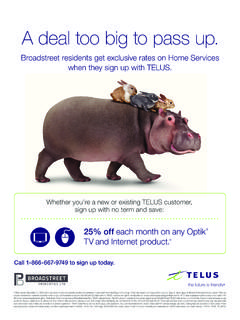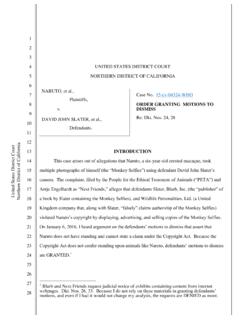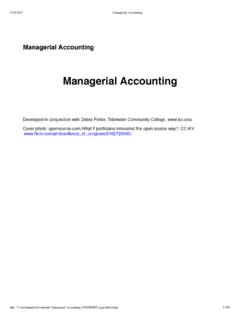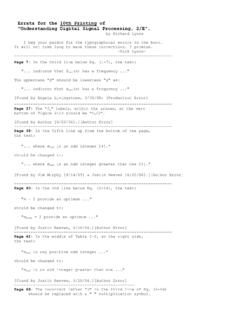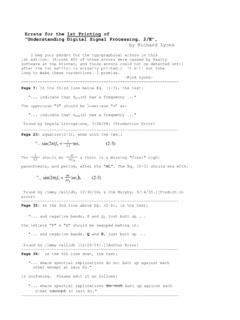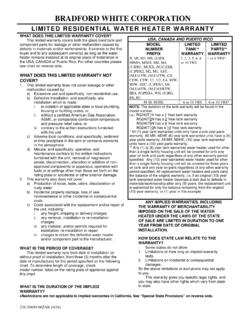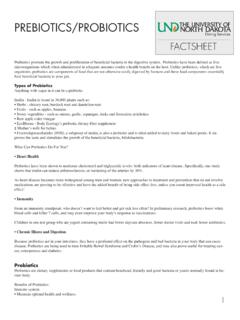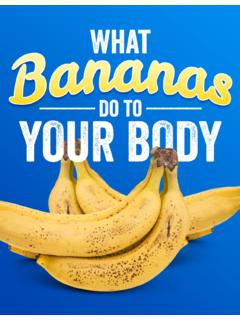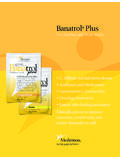Transcription of DOES YOUR DOG REALLY HAVE ALLERGIES?
1 SPECIAL REPORT: DOES your DOG REALLY . have allergies ? Discover How To Identify And Fix These 4 Common Allergy Imitators And Make your Dog's Allergy Symptoms Disappear SPECIAL REPORT: DOES your DOG REALLY . have allergies ? An allergic reaction is an inappropriate or exaggerated immune response to common foods and substances in your dog's environment (like mold, fleas or pollen). Dogs with allergies have a compromised immune system that can no longer tell the difference between enemies (like viruses and bacteria) and harmless substances (like grass and food). In some cases, the dog's immune system will even mistake his own cells for foreign invaders and attack them (this is called autoimmunity). Allergy Symptoms In Dogs While allergies in humans cause mainly respiratory symptoms, like sneezing and a runny nose, canine allergies mainly cause symptoms on the skin (on just one area or all over the body). You might see: Hot Spots Itching (pruritis). Discharge From The Eyes or Nose Licking or Chewing Digestive Issues Reddened or Blackened Skin Scooting or Licking the Anal Glands Ear Infections or Itchy Ears But if your dog has any of these symptoms, don't assume it's an allergy.
2 There are many allergy imitators that you need to rule out first and the good news is, these are much easier to treat than allergies . So let's look at the Top 4 Allergy Imitators and how to manage them. YEAST. ALLERGY IMITATOR #1. Yeast Yeast is a fungus and is in all dogs (and people) as a normal part of their flora. The most common types of yeast in dogs are Malassezia and Candida. These yeasts live in little colonies on your dog's skin, inside his ears and inside his gut, along with healthy bacteria and other flora. These little organisms outnumber your dog's own cells and they're an important part of his immune system. But those colonies can be disrupted. Vaccines, drugs and chemicals can kill off some of the beneficial flora and this allows the yeast colonies to start to grow out of control. Processed and genetically modified foods can also cause this disruption. Managing Yeast Infections These yeasts live in little colonies on your dog's skin, inside his ears and inside his gut, along with healthy bacteria and other flora.
3 YEAST. ALLERGY IMITATOR #1. Signs Of Yeast Infection When yeast populations grow out of control, you'll start to see the following symptoms in your dog: Chewing or licking the feet, and dark rusty-red hair between the toes. The Black skin, especially where hair is often red or rust-colored because there's also hair loss. of the yeast (not because of the licking). Speckles (like tiny black dots) on the Scratching the ears or head underbelly, or grayish or rust coloration shaking with a reddish around the genitals. Regular grooming discharge in the ears. should reveal this early indicator of yeast. Cyclic symptoms (appearing in the spring and going away in the fall). This is often confused with grass allergies and other spring and summer symptoms. A sweet, funky smell and greasy hair (seborrhea), often accompanied by heavy dandruff. This is an active fungal infection of the hair follicles. Hair loss on the tail and upper back The longer your dog's yeast infection goes untreated, the harder it will be to resolve, so it's important to look for these early signs.
4 YEAST. ALLERGY IMITATOR #1. Managing Yeast Infections Step 1: Eliminate Starch From The Diet Since yeast infections start in the gut, one of the first steps in treating yeast is to look at your dog's diet. In order to grow, yeast needs to eat. And yeast loves sugar. your dog might not be eating candy and drinking soda but foods that contain any type of starch will feed the yeast in her gut. Starch is just a chain of sugars and most starch is converted quickly into sugar in your dog, feeding the yeast. Foods like corn, potatoes, rice, peas, sweet potatoes and oats are examples of starchy foods. In the wild, the foods your dog's ancestors ate (as well as the foods that our human ancestors ate), contained about 4% starch. Most dog foods have ten times that amount! Even grain-free foods are usually full of potatoes, sweet potatoes or tapioca and have just as much starch as other kibbles. The solution is to feed your dog a food low in starches. Step :2 Avoid Processed Foods Most processed pet foods contain genetically modified ingredients.
5 The most commonly found GMO foods are beets, alfalfa, corn, soy, and canola. Genetically modified foods are altered so they can be sprayed with glyphosate containing Roundup and survive. Glyphosate kills pests by disabling something called the Shikimate pathway, which essentially starves them. Glyphosate is considered to be safe for humans and dogs because we don't have a Shikimate pathway but the beneficial flora that form our immune systems do. YEAST. ALLERGY IMITATOR #1. Managing Yeast Infections So genetically modified foods will kill the beneficial bacteria and flora that keep yeast colonies in check and the yeast will begin to overpopulate and cause skin issues in your dog. Other pet food ingredients can contain pesticides and these can also destroy the beneficial flora in your dog's gut and skin. And wheat (unless it's organic) is sprayed with glyphosate before it's harvested and will also cause a disruption in the gut flora. Step 3: Avoid Exposure To Drugs And Chemicals Vaccines, drugs and chemicals can also disrupt the delicate flora living in your dog.
6 Antibiotics will obviously kill any beneficial bacteria and flora and should be avoided. But other toxins can disrupt the delicate balance of intestinal flora, including vaccines, drugs, heartworm, flea, tick and parasite meds. Step 4: Rebuild A Healthy Balance Of Flora There are many different species of bacteria that live in your dog's gut and on his skin and many of them are beneficial to your dog. They produce vitamins and fatty acids and they also keep yeast populations in check. You can restore the beneficial bacteria populations in your dog by giving him probiotics and prebiotics. YEAST. ALLERGY IMITATOR #1. Probiotics There are two ways to get friendly bacteria into your dog: with probiotic products or with probiotic-rich foods. If you're looking for a probiotic product, not all of them are made the same. Here are some tips for choosing a good quality probiotic: 1. Look for a product that carries more than just a few strains of 1. bacteria. If you look on the label, you'll see a good mixture of Lactobacilli and Bifidobacteria these are the most important strains and you'll see them displayed as B.
7 And L (for example, B. lactis or L. acidophilus). 2. 2. Probiotics are measured in CFUs (colony forming units). This number should be displayed on the bottle and you'll want to look for a minimum of 10 billion CFUs. Not all of the bacteria will survive the highly acidic stomach in your dog, so the higher the CFUs, the more likely the product is to help your dog. 3. 3. Look for probiotics that aren't made from dairy or other sources that can create allergy symptoms in your dog. Dosage: If you buy a product made for dogs, follow the dosing directions on the container. You can also buy a human probiotic supplement. If you do, assume the directions are for a 150 pound human and adjust the dose to your dog's weight. YEAST. ALLERGY IMITATOR #1. Probiotic Rich Food Fermented foods like kefir, kimchi, sauerkraut or fermented vegetables are all rich in probiotics. You can feed your dog about a teaspoon per 15. pounds of body weight. Start with small amounts and work your way up. Prebiotics Adding a prebiotic will make your probiotics more effective.
8 Prebiotics are non-digestible food ingredients that feed the probiotics in the gut. You can buy prebiotic supplements like inulin and fructo- oligosaccharides. As with all human supplements, assume the dose is for a 150 lb person and adjust for your dog's weight. You can also use whole food sources of prebiotics. A couple of good ones for dogs are: Raw dandelion greens Sprinkle on food 1 teaspoon of dried greens per 20 lbs of body weight per day. Garlic Feed 1 teaspoon of chopped raw garlic per 30 lbs of your dog's weight per day. YEAST. ALLERGY IMITATOR #1. Step 5: Eliminate Starch From The Diet There are many common foods you can give your dog that have natural anti-yeast properties. Garlic is good natural prebiotic that also has anti-fungal properties. For maximum health benefits, chop fresh garlic and let it sit for 10 to 15 minutes before adding it to your dog's food. Exposing garlic to air releases allicin, the substance that provides garlic's many health benefits. Dose: 10 to 15 lbs: 1/2 clove 20 to 40 lbs: 1 clove 45 to 70 lbs: 2 cloves 75+ lbs: 2 1/2 cloves Coconut oil has antifungal properties and is another good food to add to your yeasty dog's diet.
9 It contains medium chain triglycerides (MCTs), which are made up of lauric acid, capric acid, caprylic acid, myristic acid and palmitic acid. All of these contribute to coconut oil's anti-fungal as well as antibacterial and antiviral properties. Always buy Virgin or Extra Virgin Coconut Oil (they're the same thing), preferably organic (and non-GMO), cold pressed, and packaged in a glass jar. Start slowly to avoid loose stool and work up to 1 teaspoon per day per 10 lbs of body weight. You can also use coconut oil topically, as you'll see below. Oil of oregano also has strong anti-fungal properties and is another good addition to your dog's diet. It's very powerful, so a drop or two a day is plenty for most dogs. Don't give it full strength - you need to dilute it in either oil or it will be irritating to your dog. Put one drop of oil or oregano in a teaspoon of olive or coconut oil before giving it to your dog. YEAST. ALLERGY IMITATOR #1. Step 6: Support The Immune System Supporting the immune system can help keep the yeast populations down.
10 Here are supplements you can add to your dog's diet to help boost his immune system: Astragalus Supports the liver and helps it do its job: ridding the body of toxins. Herbalist Greg Tilford recommends up to 10 drops of extract per 10. pounds of body weight, up to twice daily. Milk Thistle Seed Will prevent and repair damage to the liver and kidneys. Give your dog teaspoon per 20 pounds of body weight per day. Milk thistle shouldn't be used as a daily supplement, but only for a few weeks at a time when the liver may be stressed. Think about using milk thistle if your dog is vaccinated, on heartworm meds or dewormers, flea or tick meds or sprays, drugs, has recently had surgery or when your dog is under stress (kenneling or a change in home). YEAST. ALLERGY IMITATOR #1. Step 7: Fight Yeast On The Surface Apple cider vinegar is a great solution for yeast, especially for dogs who love the water (because yeast loves water and moist, damp skin). Fill a squeeze bottle (the kind with a long pointy end like ketchup bottles at a diner) with Bragg Organic Apple Cider Vinegar.


